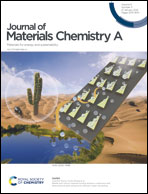Hard carbon key properties allow for the achievement of high Coulombic efficiency and high volumetric capacity in Na-ion batteries†
Abstract
The volumetric capacity and the initial Coulombic efficiency are features of major importance when it comes to the development of full-cell batteries, and are thus key characteristics to boost Na-ion batteries (NIBs) commercialization. To allow the improvement of these parameters, several hard carbon properties that are rarely addressed, such as tapped density and electrode porosity after calendaring, were investigated herein in relation with their physico-chemical characteristics and electrochemical performance. A series of sustainable and scalable synthesized hard carbon spheres with controlled properties were used in this purpose. It was found that the electrode porosity after calendaring decreases rather linearly with the graphite interlayer space (d002), the lowest value (41%) being reached for high temperature treated carbons (>1500 °C). No clear correlation could be established between the electrode porosity and the tapped density. This could be understood by the dependence of the tapped density on several interplaying parameters, including the porosity (open, closed and inter-grain) and the morphology (particle shape and size). The compact carbon electrodes could deliver a high volumetric capacity of ∼300 mA h cm−3. Such performance was achieved by combining low electrode porosity, low interlayer space, and low specific surface area as emphasized by comparison with several other lab-made and commercial hard carbons. Moreover, these carbon spheres revealed an initial Coulombic efficiency of 92%, which is among the highest value reported for hard carbon. This could be correlated in large extent with the low values of the specific surface area of ultra-micropores (<0.7 nm), and further to the low amount of active sites and oxygen-containing functional groups. Several valuable property-performance correlations could be established, allowing for predicting the behavior of hard carbons in the Na-ion half-cells and full-cells.

- This article is part of the themed collection: Energy Frontiers: Electrochemistry and Electrochemical Engineering


 Please wait while we load your content...
Please wait while we load your content...